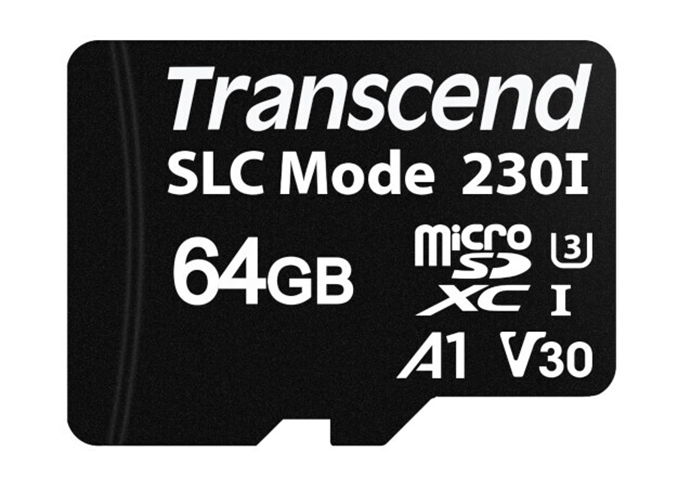Transcend Launches microSD Cards with SLC Caching
by Anton Shilov on March 30, 2020 4:30 PM EST- Posted in
- Memory Cards
- Transcend
- microSDXC

Transcend has unveiled a new series of microSD memory cards that support pseudo-SLC caching to boost burst write speeds. The new USD230I memory cards offer data transfer speeds of up to 100 MB/s as well as random read/write performance of up to 3,400 IOPS.
Transcend’s USD230I lineup includes microSD cards featuring 8 GB, 16 GB, 32 GB, and 64 GB capacities. The cards carry the A1 as well as the V30 badges, so they can be used to install Google Android applications and guarantee a minimum write speed of up to 30 MB/s, which is good enough for 4K video shooting.
Pseudo-SLC caching was introduced into the standard by the SD Association back in early 2017, but so far no actual memory cards have used this technology. Meanwhile, since Transcend’s USD230I use 3D TLC NAND memory, the only way to boost their writing performance is indeed through pSLC caching. Unfortunately, the manufacturer does not specify the sizes of its pSLC cache.
As far as endurance is concerned, the 8 GB model is rated for 36 terabytes to be written (TBW), the 16 GB/32 GB models are speced for 70 TBW, whereas the 64 GB variant is rated for 140 TBW.
Related Reading:
- SD Association Announces UHS-III (up to 624 MB/s), A2 Class, LV Signaling
- SD Association Announces SD 5.0 Specification: SD Cards For UHD and 360° Video Capture
- SanDisk Launches Max Endurance microSD Cards: 3 to 15 Years Warranty
- Kingston’s Fast SD Cards at CES 2020: UHS-II at 300 MB/s & UHS-I at 170 MB/s
- ADATA Launches microSD Cards Based on SLC NAND Memory
- Kingston Launches High-Endurance microSD Cards: Up to 128 GB
- SanDisk Launches Max Endurance microSD Cards: 3 to 15 Years Warranty
Source: TechPowerUp










19 Comments
View All Comments
shabby - Monday, March 30, 2020 - link
"write speed of up to 30 MB/s, which is good enough for 4K video shooting"Since when is 4k 240Mbps? 4k needs maybe 5-10MB/sec so any card can record 4k.
willis936 - Monday, March 30, 2020 - link
Wrong.Samus - Tuesday, March 31, 2020 - link
Are you joking? My 26MP DSLR shoots RAW files that come out to 19MB EACH. That's a single frame, albeit at "12K"My point is, you need cards of this performance just for shooting multi-frame still photography.
LarsBolender - Tuesday, March 31, 2020 - link
Have you ever heard of encoding?RadiclDreamer - Tuesday, March 31, 2020 - link
He said he is shooting RAW. For most consumers something that is encoded already is fine, but for most professional photographers they want RAW because they do not want to lose quality to compressionbenzosaurus - Monday, March 30, 2020 - link
Maybe if you use a good inter-frame codec and compress it do death it is. As it stands, the hardware encoders in most cameras are pretty rubbish. Most cameras that shoot 4K these days are pushing *at least* 30MB/s, and if you're shooting in a raw format it could easily quadruple that.shabby - Monday, March 30, 2020 - link
Perhaps we're thinking of different camera's then.shelbystripes - Tuesday, March 31, 2020 - link
Perhaps. We’re all thinking of good cameras.Maksdampf - Tuesday, March 31, 2020 - link
Yes, DSLRs especially those of the "C"-Company usually are far from delivering a good 4K quality, sometimes even worse than phones. No wonder Bitrates are just similar to good 1080p footage.You need a Fuji, Panasonic or Sony to record good 4K in F-log, 10bit and all-I for better editing capability. The XT3 and XT4 are recording 400Mbps.
Also keep in mind, that Latencys add up. So even if the Card is able to do 240Mbps with the right card readeras long as its empty, your Cameras SDcard controller could introduce some latency that makes it slower in practice.
I have this with a 64mb Card by PNY, which theoreticaly hits 90/45mb/s but hangs after a few minutes in 4K all-I recordings in an xt4.
deil - Tuesday, March 31, 2020 - link
1. you need to keep it all time its ~18 MB/s is needed.2. any other app using the card cannot stop the recording -> a bit of catch up time should also be there to make sure buffors can be flushed.
3. not all recordings are equal, and standard should say 4k will work or not, hence the overhead is added for other standards to work if needed.